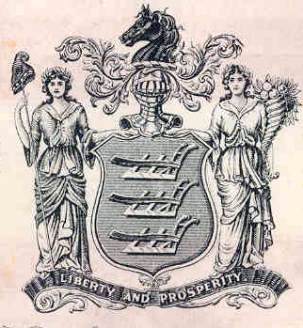Beautifully engraved certificate from the City of Jersey City issued in 1911. This historic document was printed by the Hamilton Banknote Company and has an ornate border around it with a vignette of the state seal. This item is hand signed by the City's Mayor, Director of Revenue and Finance and Clerk is over 91 years old. Minor water stain, but overall very good. 
Certificate Vignette Jersey City (1990 pop. 228,537), seat of Hudson co., NE N.J., a port on a peninsula formed by the Hudson and Hackensack rivers and Upper New York Bay, opposite lower Manhattan; settled before 1650, inc. as Jersey City 1836. The second largest city in the state and a commercial and industrial center surpassed only by Newark, it is a port of entry and a manufacturing center. With 11 mi (17.7 km) of waterfront and significant rail connections, Jersey City is an important transportation terminal point and distribution center. It has railroad shops, oil refineries, warehouses, and plants that manufacture a diverse assortment of products, such as chemicals, petroleum and electrical goods, textiles, and cosmetics. The city has benefited from its position across from the island of Manhattan, and many Jersey City companies are extensions of those originating in New York City. Further developments have included increased housing and shopping areas; other parts of the city, however, remain run-down after years of commercial activity. A large number of various ethnic groups, particularly Hispanics and Indians, live in family housing developments. The city has a modern medical center and is the seat of Jersey City State College and St. Peter's College. In Lincoln Park is a statue of Lincoln, built in 1929. Liberty State Park, on the waterfront, is the site of a science museum and provides an excellent view of New York harbor.The area was acquired by Michiel Pauw c.1629. The Dutch soon set up the trading posts of Paulus Hook, Communipaw, and Horsimus. In 1674 the site fell permanently under British rule. The fort at Paulus Hook was captured by Light-Horse Harry Lee under Washington's plan, Aug. 19, 1779. Nearby Bergen was a stockaded Dutch village dating from before 1620 and had New Jersey's first municipal government, church (Dutch Reformed), and school (1662). Jersey City was consolidated with Bergen and Hudson City in 1869; the town of Greenville was added in 1873. The city's industrial growth began in the 1840s with the arrival of the railroad and the improvement of its water transport system. In 1916, Jersey City docks were the scene of the Black Tom explosion that caused widespread property damage.The city has benefited from its position across from the island of Manhattan, and many Jersey City companies are extensions of those originating in New York City. Further developments have included increased housing and shopping areas; other parts of the city, however, remain run-down after years of commercial activity. A large number of various ethnic groups, particularly Hispanics and Indians, live in family housing developments. The city has a modern medical center and is the seat of Jersey City State College and St. Peter's College. In Lincoln Park is a statue of Lincoln, built in 1929. Liberty State Park, on the waterfront, is the site of a science museum and provides an excellent view of New York harbor.

Certificate Vignette













